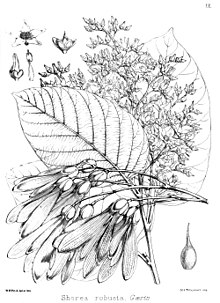Shorea robusta
| Sal | |
|---|---|

| |
| Scientific classification | |
| Kingdom: | |
| (unranked): | |
| (unranked): | |
| (unranked): | |
| Order: | |
| Family: | |
| Genus: | |
| Species: | S. robusta
|
| Binomial name | |
| Shorea robusta | |
| Synonyms | |
|
Vatica robusta | |
Shorea robusta, also known as śāl or shala tree, is a species of tree belonging to the Dipterocarpaceae family.
Distribution and description

This tree is native to the Indian subcontinent, ranging south of the Himalaya, from Myanmar in the east to Nepal, India and Bangladesh. In India, it extends from Assam, Bengal, Odisha and Jharkhand west to the Shivalik Hills in Haryana, east of the Yamuna. The range also extends through the Eastern Ghats and to the eastern Vindhya and Satpura ranges of central India.[1] It is often the dominant tree in the forests where it occurs. In Nepal, it is found mostly in the terai region from east to west, especially, in the Churia range (the Shivalik Hill Churia Range) in the subtropical climate zone. There are many protected areas, such as Chitwan National Park, Bardia National Park and Shukla Phat National Park, where there are dense forests of huge sal trees. It is also found in the lower belt of the hilly region and inner terai.

Sal tree is also known as Sakhua in northern India including MP, Orrisa and Jharkhand.[2] [3]
Sal is moderate to slow growing, and can attain heights of 30 to 35 m and a trunk diameter of up to 2-2.5 m. The leaves are 10–25 cm long and 5–15 cm broad. In wetter areas, it is evergreen; in drier areas, it is dry-season deciduous, shedding most of the leaves in between February to April, leafing out again in April and May.
Religious significance

In Hindu tradition, the sal tree is said to be favoured by Vishnu.[4] Its name shala, shaal or sal, comes from Sanskrit (शाल, śāla, literally "house"), a name that suggests it for housing timber; other names in the Sanskrit language are ashvakarna, chiraparna and sarja, among many others.
The sal tree is often confused with the ashoka tree (Saraca indica) in the ancient literature of the Indian Subcontinent.
In Buddhist tradition, it is said that Queen Māyā of Sakya gave birth to Gautama Buddha under a sal tree or an asoka tree in a garden in Lumbini, in south Nepal, while grasping its branch. When this event took place, Queen Māyā was en route to birth him in his grandfather's kingdom.[5] It is also said that four pairs of sal trees growing around the Buddha's bed suddenly turned white when he died.
Jains state that the 24th tirthankara, Mahavira, achieved enlightenment under a sal.
There is a standard decorative element of Hindu Indian sculpture which originated in a yakshi grasping the branch of a flowering tree while setting her foot against its roots.[6] This decorative sculptural element was integrated into Indian temple architecture as salabhanjika or "sal tree maiden", although it is not clear either whether it is a sal tree or an asoka tree.[7]
In Kathmandu Valley of Nepal, one can find typical Nepali pagoda temple architectures with very rich wooden carvings, and most of the temples, such as Nyatapol Temple (Nyatapola), are made of bricks and sal tree wood.
Uses
Sal is one of the most important sources of hardwood timber in India, with hard, coarse-grained wood that is light in colour when freshly cut, but becomes dark brown with exposure. The wood is resinous and durable, and is sought-after for construction, although not well suited to planing and polishing. The wood is especially suitable for constructing frames for doors and windows. The dry leaves of sal are a major source for the production of leaf plates called as patravali and leaf bowls in northern and eastern India. The leaves are also used fresh to serve ready made paan (betelnut preparations) and small snacks such as boiled black grams, gol gappa, etc. The used leaves/plates are readily eaten by goats and cattle that roam the streets freely. The tree has therefore protected northern India from a flood of styrofoam and plastic plates that would have caused tremendous pollution. In South India, fresh plantain and banana leaves are used instead.
Sal tree resin, ṛla in Sanskrit, is used as an astringent in Ayurvedic medicine.[8] It is also burned as incense in Hindu ceremonies, and sal seeds and fruit are a source of lamp oil and vegetable fat. shorea robusta seed oilis extracted from the seeds and used as cooking oil after refining.
Gallery
-
Sal trunk constricted by a ficus tree at Jayanti
-
Old leaf at Jayanti
-
Flowering canopy at Jayanti
See also
References
- ^ Oudhia P., Ganguali R.N. (1998).Is Lantana camara responsible for Sal-borer infestation in M.P.?. Insect Environment. 4 (1): 5.
- ^ http://infochangeindia.org/environment/stories-of-change/a-rakhi-for-trees.html
- ^ http://bjmirror0112.wordpress.com/
- ^ Sacred trees
- ^ http://www.flowersofindia.net/catalog/slides/Sal.html
- ^ Buddhistische Bilderwelt: Hans Wolfgang Schumann, Ein ikonographisches Handbuch des Mahayana- und Tantrayana-Buddhismus. Eugen Diederichs Verlag. Cologne. ISBN 3-424-00897-4, ISBN 978-3-424-00897-5
- ^ Eckard Schleberger, Die indische Götterwelt. Gestalt, Ausdruck und Sinnbild Eugen Diederich Verlag. Cologne. ISBN 3-424-00898-2, ISBN 978-3-424-00898-2
- ^ Sala, Asvakarna





